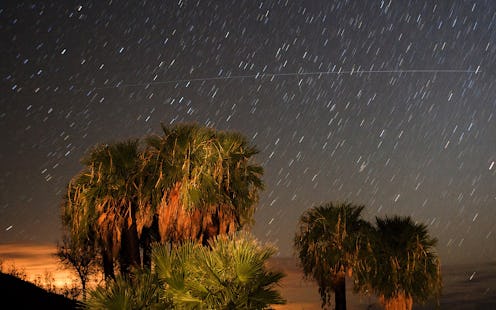Life
A Brief Explainer Of The Eta Aquariids Meteor Shower

According to Merriam-Webster, "spectacular" literally means "being or relating to a spectacle". So to say that the sight of a meteor shower is spectacular is not an opinion, but merely a fact. Whether you're super into star stuff or not, you're going to want to know about what the Eta Aquariids meteor shower of 2017 is, because it's kind of a big deal. A spectacularly big deal, to be specific.
The Eta Aquariids occur each spring between April 22 and May 20. And this year, the peak performance is estimated for May 6. But why is this meteor shower any more special than the others? Well, first, it comes from Haley's Comet, which you've probably heard of before, because well, it's kind of a big deal. Haley's Comet is only visible from Earth once ever 76 years, so unless you're a vampire, catching a sight of that comet is a once in a lifetime opportunity, literally. The next time the comet is slated to be visible from Earth is 2061, which is maybe our side of some of our lifetimes. So the fact that we at least get to see the Eta Aquariids is pretty cool. It's maybe the closest we'll get to seeing any part of Haley's Comet, as meteors are little icy, burning bits of dust and debris that have broken off from a comet. Never is an eternal mess more beautiful than when it's in space, amirite?
Technically speaking, this meteor shower in particular is much more visible in the southern hemisphere than it is in the northern hemisphere — but fear not, you'll still see about 30 meteors per hour on the peak night. What that means for people in the southern hemisphere though, is that they'll see upwards of 60 meteors an hour. So like, book your tickets to Australia, or just settle on a slightly less active but totally thrilling meteor shower set to blaze through your skyscape on May 6.
According to the folks over at NASA, the shower is totally visible to the naked eye, but your best bet in getting ultimate visibility is going someplace dark to watch the show. For example, avoid the Las Vegas strip and Times Square. NASA also suggests that you make a night of it and lay down on a blanket to watch the show. Not only will it make the experience more relaxing, but you'll have a larger field of view and will be less likely to miss something.
So mark your calendar, make sure that you get outside on May 6. Because it's a Saturday night, you might want to consider throwing a nighttime picnic or something fun to get some friends together to watch the show with you.